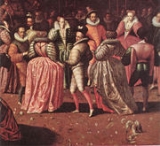
Catherine de' Medici's court festivals
Encyclopedia
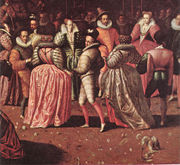
Catherine de' Medici
Catherine de' Medici was an Italian noblewoman who was Queen consort of France from 1547 until 1559, as the wife of King Henry II of France....
, the queen consort
Queen consort
A queen consort is the wife of a reigning king. A queen consort usually shares her husband's rank and holds the feminine equivalent of the king's monarchical titles. Historically, queens consort do not share the king regnant's political and military powers. Most queens in history were queens consort...
of France from 1547 to 1559 and queen mother from 1559 until her death in 1589. As queen consort of Henry II of France
Henry II of France
Henry II was King of France from 31 March 1547 until his death in 1559.-Early years:Henry was born in the royal Château de Saint-Germain-en-Laye, near Paris, the son of Francis I and Claude, Duchess of Brittany .His father was captured at the Battle of Pavia in 1525 by his sworn enemy,...
, Catherine showed interest in the arts and theatre, but it was not until she attained real political and financial power as queen mother that she began the series of tournaments
Tournament (medieval)
A tournament, or tourney is the name popularly given to chivalrous competitions or mock fights of the Middle Ages and Renaissance . It is one of various types of hastiludes....
and entertainments that dazzled her contemporaries and continue to fascinate scholars. Biographer Leonie Frieda
Leonie Frieda
Leonie Frieda is a Swedish-born former model, translator, and writer, working and living in the United Kingdom.Educated in the UK, France and Germany, Ms. Frieda speaks five languages...
suggests that "Catherine, more than anyone, inaugurated the fantastic entertainments for which later French monarchs also became renowned".
For Catherine, these entertainments served a political purpose that made them worth their colossal expense. She presided over the royal government at a time when the French monarchy was in steep decline. With three of her sons on the throne in succession and the country torn by religious civil war
French Wars of Religion
The French Wars of Religion is the name given to a period of civil infighting and military operations, primarily fought between French Catholics and Protestants . The conflict involved the factional disputes between the aristocratic houses of France, such as the House of Bourbon and House of Guise...
, Catherine set out to show not only the French people but foreign courts that the Valois monarchy was as prestigious and magnificent as it had been during the reigns of Francis I
Francis I of France
Francis I was King of France from 1515 until his death. During his reign, huge cultural changes took place in France and he has been called France's original Renaissance monarch...
and her husband Henry II. At the same time, she believed these elaborate entertainments and sumptuous court rituals, which incorporated martial sports and tournaments of many kinds, would occupy her feuding nobles and distract them from fighting against each other to the detriment of the country and the royal authority.
It is clear, however, that Catherine regarded these festivals as more than political and pragmatic exercises: she revelled in them as a vehicle for her creative gifts. A highly talented and artistic woman, Catherine took the lead in devising and planning her own musical-mythological shows. Though they were ephemeral
Ephemeral
Ephemeral things are transitory, existing only briefly. Typically the term is used to describe objects found in nature, although it can describe a wide range of things....
, her "magnificences"—as the contemporary commentator Pierre de Bourdeille, seigneur de Brantôme
Pierre de Bourdeille, seigneur de Brantôme
Pierre de Bourdeille, seigneur de Brantôme was a French historian, soldier and biographer.-Life:Brantôme was born in Périgord, Aquitaine, the third son of the baron de Bourdeille...
, called them—are studied by modern scholars as works of art. Historian Frances Yates
Frances Yates
Dame Frances Amelia Yates DBE was a British historian. She taught at the Warburg Institute of the University of London for many years.She wrote extensively on the occult or Neoplatonic philosophies of the Renaissance...
has called Catherine "a great creative artist in festivals". She employed the leading artists and architects of the day to create the necessary dramas, music, and scenic effects for these events, which were usually dedicated to the ideal of peace and based on mythological
Mythology
The term mythology can refer either to the study of myths, or to a body or collection of myths. As examples, comparative mythology is the study of connections between myths from different cultures, whereas Greek mythology is the body of myths from ancient Greece...
themes.
It is difficult for scholars to piece together the exact form of the entertainments, but clues have been gleaned from the written accounts, scripts, artworks, and tapestries that derived from these famous occasions. Though such sources must be treated with caution, since they contain demonstrable inaccuracies and contradictions, they provide evidence of the richness and scale of Catherine de' Medici's court festivals.
Entertainments
Catherine de' Medici's investment in magnificent entertainments was part of a conscious political programme. She recalled the belief of her father-in-law, King Francis IFrancis I of France
Francis I was King of France from 1515 until his death. During his reign, huge cultural changes took place in France and he has been called France's original Renaissance monarch...
, that the court needed to be physically active and constantly entertained. She also declared her intention to imitate the Roman emperors, who kept their subjects from mischief by occupying them with games and amusements. She therefore adopted a policy of distracting her nobles from fighting among themselves by laying on irresistible entertainments and sports for them at court.
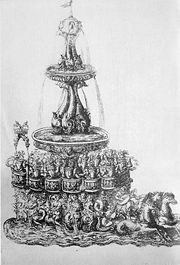
Jeanne III of Navarre
Jeanne d'Albret , also known as Jeanne III or Joan III, was the queen regnant of Navarre from 1555 to 1572. She married Antoine de Bourbon, Duke of Vendôme, and was the mother of Henry of Bourbon, who became King of Navarre and of France as Henry IV, the first Bourbon king...
, wrote from the court to warn her son Henry
Henry IV of France
Henry IV , Henri-Quatre, was King of France from 1589 to 1610 and King of Navarre from 1572 to 1610. He was the first monarch of the Bourbon branch of the Capetian dynasty in France....
that Catherine presided over a "vicious and corrupt" atmosphere, in which the women made the sexual advances and not the men. In fact, Charlotte de Sauve
Charlotte de Sauve
Charlotte de Beaune Semblançay, Viscountess of Tours, Baroness de Sauve, Marquise de Noirmoutier was a French noblewoman and a mistress of King Henry of Navarre, who later ruled as King Henry IV of France...
, one of the most notorious members of the "flying squadron", first seduced and then became a mistress of Henry of Navarre on Catherine's orders. On the other hand, Brantôme
Pierre de Bourdeille, seigneur de Brantôme
Pierre de Bourdeille, seigneur de Brantôme was a French historian, soldier and biographer.-Life:Brantôme was born in Périgord, Aquitaine, the third son of the baron de Bourdeille...
, in his Memoirs, praised Catherine’s court as "a school of all honesty and virtue".
In the tradition of sixteenth-century royal festivals, Catherine de' Medici's magnificences took place over several days, with a different entertainment each day. Often individual nobles or members of the royal family were responsible for preparing one particular entertainment. Spectators and participants, including those involved in martial sports, would dress up in costumes representing mythological or romantic themes. Catherine gradually introduced changes to the traditional form of these entertainments. She forbade heavy tilting
Jousting
Jousting is a martial game or hastilude between two knights mounted on horses and using lances, often as part of a tournament.Jousting emerged in the High Middle Ages based on the military use of the lance by heavy cavalry. The first camels tournament was staged in 1066, but jousting itself did not...
of the sort that led to the death of her husband in 1559; and she developed and increased the prominence of dance in the shows that climaxed each series of entertainments. As a result, the ballets de cour
Ballets de cour
Ballets de cour is the name given to ballets performed in the 16th and 17th centuries at court. Jean-Baptiste Lully is considered the most important composer of music for ballets de cour and was instrumental to the development of the form...
, a distinctive new art form, emerged from the creative advances in court entertainment devised by Catherine de' Medici.
Fontainebleau

Charles IX of France
Charles IX was King of France, ruling from 1560 until his death. His reign was dominated by the Wars of Religion. He is best known as king at the time of the St. Bartholomew's Day Massacre.-Childhood:...
embarked on a royal progress that was to last nearly two and a half years. They were accompanied by what has been described as a city on the move, including the King’s Council and foreign ambassadors who Catherine hoped would report to their governments on the splendour of the train, offsetting any idea that the French monarchy was on the verge of bankruptcy. The royal household included Catherine’s courtiers and "flying squadron", as well as her musicians and nine essential dwarves who travelled in their own miniature coaches. The party carried with it all the equipment and paraphernalia
Paraphernalia
In modern usage, the word paraphernalia most commonly refers to apparatus, equipment, or furnishing used in or necessary for a particular activity as in, "Beth is such an avid sports fan that her walls are covered with baseball paraphernalia"....
required for the festivals, feasts, masques, and joyeuses entrées
Royal Entry
The Royal Entry, also known by various other names, including Triumphal Entry and Joyous Entry, embraced the ceremonial and festivities accompanying a formal entry by a ruler or his representative into a city in the Middle Ages and Early Modern Period in Europe...
planned to take place along the route. These included portable triumphal arches and the royal barges.
Catherine had ordered that at the Château de Fontainebleau
Château de Fontainebleau
The Palace of Fontainebleau, located 55 kilometres from the centre of Paris, is one of the largest French royal châteaux. The palace as it is today is the work of many French monarchs, building on an early 16th century structure of Francis I. The building is arranged around a series of courtyards...
, each important noble should host a ball. She herself held a banquet in a meadow at the château's dairy
Dairy
A dairy is a business enterprise established for the harvesting of animal milk—mostly from cows or goats, but also from buffalo, sheep, horses or camels —for human consumption. A dairy is typically located on a dedicated dairy farm or section of a multi-purpose farm that is concerned...
, where her courtiers dressed as shepherds and shepherdesses. That evening, the court watched a comedy in the great ballroom, which was followed by a ball where 300 "beauties dressed in gold and silver cloth" performed a choreographed dance.
At Fontainebleau, Catherine arranged entertainments that lasted for several days, including fancy-dress jousting
Jousting
Jousting is a martial game or hastilude between two knights mounted on horses and using lances, often as part of a tournament.Jousting emerged in the High Middle Ages based on the military use of the lance by heavy cavalry. The first camels tournament was staged in 1066, but jousting itself did not...
and chivalrous
Chivalry
Chivalry is a term related to the medieval institution of knighthood which has an aristocratic military origin of individual training and service to others. Chivalry was also the term used to refer to a group of mounted men-at-arms as well as to martial valour...
events in allegorical
Allegory
Allegory is a demonstrative form of representation explaining meaning other than the words that are spoken. Allegory communicates its message by means of symbolic figures, actions or symbolic representation...
settings. On Mardi Gras
Mardi Gras
The terms "Mardi Gras" , "Mardi Gras season", and "Carnival season", in English, refer to events of the Carnival celebrations, beginning on or after Epiphany and culminating on the day before Ash Wednesday...
, the day after the banquet in the meadow, knights dressed as Greeks and Trojans
Troy
Troy was a city, both factual and legendary, located in northwest Anatolia in what is now Turkey, southeast of the Dardanelles and beside Mount Ida...
fought over scantily clad damsels
Damsel in distress
The subject of the damsel in distress, or persecuted maiden, is a classic theme in world literature, art, and film. She is usually a beautiful young woman placed in a dire predicament by a villain or monster and who requires a hero to achieve her rescue. She has become a stock character of fiction,...
trapped by a giant and a dwarf in a tower on an enchanted island. The fighting climaxed with the tower losing its magical properties and bursting into flames. In another spectacle, singing siren
Siren
In Greek mythology, the Sirens were three dangerous mermaid like creatures, portrayed as seductresses who lured nearby sailors with their enchanting music and voices to shipwreck on the rocky coast of their island. Roman poets placed them on an island called Sirenum scopuli...
s swam past the king, and Neptune
Neptune
Neptune is the eighth and farthest planet from the Sun in the Solar System. Named for the Roman god of the sea, it is the fourth-largest planet by diameter and the third largest by mass. Neptune is 17 times the mass of Earth and is slightly more massive than its near-twin Uranus, which is 15 times...
floated by in a chariot drawn by seahorses.
Bayonne
As the high point of the royal progress, Catherine scheduled a meeting with her daughter ElisabethElisabeth of Valois
Elisabeth of Valois was the eldest daughter of Henry II of France and Catherine de' Medici.-Early life:She was born in the Château de Fontainebleau...
, the third wife of Philip II of Spain
Philip II of Spain
Philip II was King of Spain, Portugal, Naples, Sicily, and, while married to Mary I, King of England and Ireland. He was lord of the Seventeen Provinces from 1556 until 1581, holding various titles for the individual territories such as duke or count....
. Catherine was so determined to make a magnificent impression on the Spanish court that she indulged in a spending spree that was extravagant even by her own standards. To help pay for the planned pageantry and entertainments, she borrowed 700,000 écus from the Gondi bank
Gondi bank
The Florentine banking family of the Gondi were prominent financial partners of the Medici. Unlike the Medici, they were of the old Florentione nobility, tracing their line traditionally from the legendary Philippi, said to have been ennobled by Charlemagne himself, in 805; from him the Strozzi...
. Catherine had assumed she would also be meeting King Philip himself, but early in the tour, he sent word that he would not be attending. He was outraged that Catherine, whom he called "Madame La Serpente", had received an embassy from the Sultan of Turkey. He also objected to her Edict of Amboise
Edict of Amboise
The Edict of Amboise was signed at the Château of Amboise on March 19, 1563 by Catherine de' Medici, acting as regent for her son Charles IX of France. The treaty officially ended the first phase of the French Wars of Religion...
(1563), which had offered concessions to the Huguenots. In short, French religious policy disgusted him. In his place he sent "the severe and ferocious" Duke of Alba
Fernando Álvarez de Toledo, 3rd Duke of Alba
Don Fernando Álvarez de Toledo y Pimentel, 3rd Duke of Alba was a Spanish general and governor of the Spanish Netherlands , nicknamed "the Iron Duke" in the Low Countries because of his harsh and cruel rule there and his role in the execution of his political opponents and the massacre of several...
, with orders to convince Catherine that persecuting, imprisoning, and torturing Huguenots was the way to deal with heretics, not making treaties with them. In the event, Catherine left Alba befuddled by her darting mind. He found her far more interested in discussing marriage alliances and in showing him what the French court could lay on in the way of fabulous entertainments.
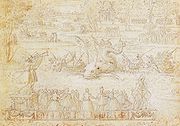
Bidasoa
The Bidasoa is a river in the Basque Country of northern Spain and southern France that runs largely south to north. Named as such downstream of the small town of Oronoz-Mugairi in the province of Navarre, the river actually results from the merge of several streams near the village Erratzu, with...
river on the Spanish border with a huge escort of French Catholic nobles on 14 June 1565. She then rode into Saint-Jean de Luz, where Catherine greeted her tearfully with embraces and kisses. During the reception ceremonies, ten of Catherine’s soldiers dropped dead from standing too long in the heat in their armour. The next day, Elisabeth made a dazzling entry into Bayonne
Bayonne
Bayonne is a city and commune in south-western France at the confluence of the Nive and Adour rivers, in the Pyrénées-Atlantiques department, of which it is a sub-prefecture...
on a horse whose harness was studded with gems worth 400,000 ducats.
The encounter between the two courts was marked by ritual exchanges of costly gifts and a sustained display of ballets, jousts, mock battles, and decorative arts. Several accounts of the Bayonne entertainments survive. One spectacle, mounted on the Bidasoa river, is a particularly famous example of Catherine’s entertainments as ephemeral
Ephemeral
Ephemeral things are transitory, existing only briefly. Typically the term is used to describe objects found in nature, although it can describe a wide range of things....
works of art. The entertainments began with a banquet on the Île d’Aguineau. As guests were ferried on decorated boats to the island, they passed, among other spectacles, Arion
Arion
Arion was a kitharode in ancient Greece, a Dionysiac poet credited with inventing the dithyramb: "As a literary composition for chorus dithyramb was the creation of Arion of Corinth," The islanders of Lesbos claimed him as their native son, but Arion found a patron in Periander, tyrant of Corinth...
riding two dolphins, harpoonists spearing an artificial whale that spouted red wine, and six tritons
Triton (mythology)
Triton is a mythological Greek god, the messenger of the big sea. He is the son of Poseidon, god of the sea, and Amphitrite, goddess of the sea, whose herald he is...
sitting on a giant turtle, blowing conch
Conch
A conch is a common name which is applied to a number of different species of medium-sized to large sea snails or their shells, generally those which are large and have a high spire and a siphonal canal....
shells. Charles IX was transported on a barge dressed to look like a floating fortress. The banquet was followed by a ballet of nymphs and satyrs. Brantôme reported that the "magnificence was such in everything that the Spaniards who are very contemptuous of all others save their own swore that they had never seen anything finer".
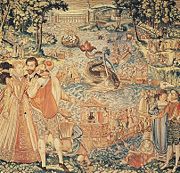
Charles IX of France
Charles IX was King of France, ruling from 1560 until his death. His reign was dominated by the Wars of Religion. He is best known as king at the time of the St. Bartholomew's Day Massacre.-Childhood:...
and his brother Henry
Henry III of France
Henry III was King of France from 1574 to 1589. As Henry of Valois, he was the first elected monarch of the Polish-Lithuanian Commonwealth with the dual titles of King of Poland and Grand Duke of Lithuania from 1573 to 1575.-Childhood:Henry was born at the Royal Château de Fontainebleau,...
took part in a tournament
Tournament (medieval)
A tournament, or tourney is the name popularly given to chivalrous competitions or mock fights of the Middle Ages and Renaissance . It is one of various types of hastiludes....
, leading teams dressed as British and Irish knights. The theme of the tournament, "virtue and love", was represented by two chariots, one containing ladies dressed as the five virtues
Five Virtues
In Sikhism, the Five Virtues are fundamental qualities which one should develop in order to reach Mukti, or to reunite or merge with God. The Sikh Gurus taught that these positive human qualities were Sat , Daya , Santokh , Nimrata , and Pyar .-Sat:Sat is the virtue of truthful living, which means...
, the other carrying Venus
Venus
Venus is the second planet from the Sun, orbiting it every 224.7 Earth days. The planet is named after Venus, the Roman goddess of love and beauty. After the Moon, it is the brightest natural object in the night sky, reaching an apparent magnitude of −4.6, bright enough to cast shadows...
and Cupid
Cupid
In Roman mythology, Cupid is the god of desire, affection and erotic love. He is the son of the goddess Venus and the god Mars. His Greek counterpart is Eros...
and many mini-cupids. In the tournament itself, little balls of fire were lobbed among the horses as they crossed. The royal grandstand was hung with gold-and-silk tapestries
Tapestry
Tapestry is a form of textile art, traditionally woven on a vertical loom, however it can also be woven on a floor loom as well. It is composed of two sets of interlaced threads, those running parallel to the length and those parallel to the width ; the warp threads are set up under tension on a...
illustrating the triumph
Roman triumph
The Roman triumph was a civil ceremony and religious rite of ancient Rome, held to publicly celebrate and sanctify the military achievement of an army commander who had won great military successes, or originally and traditionally, one who had successfully completed a foreign war. In Republican...
of Scipio
Scipio Aemilianus Africanus
Publius Cornelius Scipio Aemilianus Africanus Numantinus , also known as Scipio Aemilianus or Scipio Africanus the Younger, was a leading general and politician of the ancient Roman Republic...
, which Giulio Romano
Giulio Romano
Giulio Romano was an Italian painter and architect. A pupil of Raphael, his stylistic deviations from high Renaissance classicism help define the 16th-century style known as Mannerism...
had designed for Francis I. Brantôme
Pierre de Bourdeille, seigneur de Brantôme
Pierre de Bourdeille, seigneur de Brantôme was a French historian, soldier and biographer.-Life:Brantôme was born in Périgord, Aquitaine, the third son of the baron de Bourdeille...
recalled in his memoirs that "the Spanish lords and ladies greatly admired it, never having seen anything like it in the possession of their king". Another French spectator recorded, "Strangers of all nations were now forced to recognise that in these things France had surpassed, with these parades, bravado, glories and magnificences, all other nations and even herself".
Catherine believed she had showed Spain that the French monarchy, far from being financially ruined and at war with its nobles, remained a glorious force to be reckoned with, capable of financing displays on a stunning scale, backed by a unified court. The point was lost on the grim Duke of Alba, however. His letters reveal his frustration that Catherine’s spectacles kept interrupting the serious business of discussing how to make war on the Protestants. In the end, the Spanish decided the whole meeting been a waste of time, since Catherine had refused to change her policy towards the Huguenots in the slightest. The Huguenots, however, believed that their banishment from the talks between the two negotiating teams meant that Catherine had struck a secret deal with the Spanish to persecute them.
Royal wedding
The celebrations following the marriage of Catherine’s daughter MargueriteMarguerite de Valois
Margaret of Valois was Queen of France and of Navarre during the late sixteenth century...
to the Protestant Henry of Navarre
Henry IV of France
Henry IV , Henri-Quatre, was King of France from 1589 to 1610 and King of Navarre from 1572 to 1610. He was the first monarch of the Bourbon branch of the Capetian dynasty in France....
in Paris on 18 August 1572, were based on Huguenot
Huguenot
The Huguenots were members of the Protestant Reformed Church of France during the 16th and 17th centuries. Since the 17th century, people who formerly would have been called Huguenots have instead simply been called French Protestants, a title suggested by their German co-religionists, the...
themes. The match was controversial because Marguerite was marrying a Huguenot. The pope refused to grant a dispensation for the marriage, and the different faiths of the bridal couple made for an unusual wedding service. After a nuptial lunch, four days of balls, masques and banquets ensued.
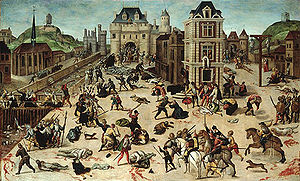
Hell
In many religious traditions, a hell is a place of suffering and punishment in the afterlife. Religions with a linear divine history often depict hells as endless. Religions with a cyclic history often depict a hell as an intermediary period between incarnations...
where, according to an observer, "a great number of devils and imps were making infinite follery and noise". The nymphs then danced a ballet. There followed combat between knights, accompanied by explosions of gunpowder. The king and his brothers climaxed proceedings by rescuing the Huguenots from hell, which was separated from paradise by a river on which floated the ferryman Charon
Charon (mythology)
In Greek mythology, Charon or Kharon is the ferryman of Hades who carries souls of the newly deceased across the rivers Styx and Acheron that divided the world of the living from the world of the dead. A coin to pay Charon for passage, usually an obolus or danake, was sometimes placed in or on...
in his boat.
The remaining festivities were called off after an assassination
Assassination
To carry out an assassination is "to murder by a sudden and/or secret attack, often for political reasons." Alternatively, assassination may be defined as "the act of deliberately killing someone, especially a public figure, usually for hire or for political reasons."An assassination may be...
attempt on the Huguenot leader Admiral Coligny
Gaspard de Coligny
Gaspard de Coligny , Seigneur de Châtillon, was a French nobleman and admiral, best remembered as a disciplined Huguenot leader in the French Wars of Religion.-Ancestry:...
, who was shot from a house by an arquebus
Arquebus
The arquebus , or "hook tube", is an early muzzle-loaded firearm used in the 15th to 17th centuries. The word was originally modeled on the German hakenbüchse; this produced haquebute...
ier on 22 August and wounded in the elbow and hand. The day before, the king and his brothers had dressed as Amazons
Amazons
The Amazons are a nation of all-female warriors in Greek mythology and Classical antiquity. Herodotus placed them in a region bordering Scythia in Sarmatia...
to fight Navarre and his friends, who wore turbans and golden robes in the role of Turks. Fighting broke out for real between the Catholics and Huguenots in the St. Bartholomew's Day massacre
St. Bartholomew's Day massacre
The St. Bartholomew's Day massacre in 1572 was a targeted group of assassinations, followed by a wave of Roman Catholic mob violence, both directed against the Huguenots , during the French Wars of Religion...
, which began on 24 August when Charles IX ordered the slaughter of all the Huguenot leaders in Paris, provoking massacres of Huguenots throughout France. Henry of Navarre was given the choice of death, life imprisonment, or conversion to Catholicism. He chose Catholicism and was spared.
Tuileries
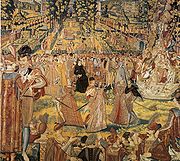
Henry III of France
Henry III was King of France from 1574 to 1589. As Henry of Valois, he was the first elected monarch of the Polish-Lithuanian Commonwealth with the dual titles of King of Poland and Grand Duke of Lithuania from 1573 to 1575.-Childhood:Henry was born at the Royal Château de Fontainebleau,...
. Sports were laid on, including tournaments, mock combats, tilting at the quintain
Hastilude
Hastilude is a generic term used in the Middle Ages to refer to many kinds of martial games. The word comes from the Latin hastiludium, literally "lance game"'...
, and running at the ring. Catherine held a grand ball or "festin" at the Tuileries palace, which Jean Dorat
Jean Daurat
Jean Daurat was a French poet, scholar, and a member of a group known as The Pléiade.-Early life:...
described in his illustrated Magnificentissimi spectaculi. Sixteen nymphs, representing each of the French provinces, danced an intricate ballet, distributing devices to the spectators in the process. Brantôme
Pierre de Bourdeille, seigneur de Brantôme
Pierre de Bourdeille, seigneur de Brantôme was a French historian, soldier and biographer.-Life:Brantôme was born in Périgord, Aquitaine, the third son of the baron de Bourdeille...
called this performance "the finest ballet that was ever given in this world" and praised Catherine for bringing France so much prestige with "all these inventions". The chronicler Agrippa d'Aubigné
Agrippa d'Aubigné
Théodore-Agrippa d'Aubigné was a French poet, soldier, propagandist and chronicler. His epic poem Les Tragiques is widely regarded as his masterpiece.-Life:...
recorded that the Poles marvelled at the ballet. Frances Yates
Frances Yates
Dame Frances Amelia Yates DBE was a British historian. She taught at the Warburg Institute of the University of London for many years.She wrote extensively on the occult or Neoplatonic philosophies of the Renaissance...
has pointed out that the Italian influence on the French ballet de cour
Ballets de cour
Ballets de cour is the name given to ballets performed in the 16th and 17th centuries at court. Jean-Baptiste Lully is considered the most important composer of music for ballets de cour and was instrumental to the development of the form...
owed much to Catherine:
It was invented in the context of the chivalrous pastimes of the court, by an Italian, and a Medici, the Queen Mother. Many poets, artists, musicians, choreographers, contributed to the result, but it was she who was the inventor, one might perhaps say, the producer; she who had the ladies of her court trained to perform these ballets in settings of her devising.
Joyeuse magnificences
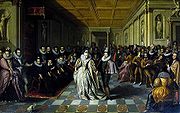

Fête
Fête is a French word meaning festival, celebration or party, which has passed into English as a label that may be given to certain events.-Description:It is widely used in England and Australia in the context of a village fête,...
was held during the reign of Catherine’s son Henry III
Henry III of France
Henry III was King of France from 1574 to 1589. As Henry of Valois, he was the first elected monarch of the Polish-Lithuanian Commonwealth with the dual titles of King of Poland and Grand Duke of Lithuania from 1573 to 1575.-Childhood:Henry was born at the Royal Château de Fontainebleau,...
to celebrate the marriage of his sister-in-law, Marguerite of Lorraine
Marguerite of Lorraine
Marguerite of Lorraine was a duchess of Orléans and Alençon. She was born in Nancy, Lorraine to Francis II, Duke of Lorraine, and Countess Christina of Salm. On 31 January 1632, she married Gaston, Duke of Orléans, son of Henry IV of France and Marie de' Medici...
, to his favourite, Anne, Duke of Joyeuse
Anne de Joyeuse
Anne de Batarnay de Joyeuse, Baron d'Arques, Vicomte then Duke of Joyeuse was a royal favourite and active participant in the French Wars of Religion....
, on 24 September 1581. Entertainments were laid on almost every day for two weeks after the wedding, in what art historian Roy Strong
Roy Strong
Sir Roy Colin Strong FRSL is an English art historian, museum curator, writer, broadcaster and landscape designer. He has been director of both the National Portrait Gallery and the Victoria and Albert Museum in London...
has called "the climax of Valois festival art". The chief artist employed to design the magnificences was Antoine Caron
Antoine Caron
Antoine Caron was a French master glassmaker, illustrator, Northern Mannerist painter and a product of the School of Fontainebleau.He is one of the few French painters of his time who had a pronounced artistic personality...
, who was aided by the sculptor Germain Pilon
Germain Pilon
Germain Pilon was a French Renaissance sculptor.-Biography:He was born in Paris. Trained by his father and Pierre Bontemps, Pilon was an expert with marble, bronze, wood and terra cotta; from about 1555 he was providing models for Parisian goldsmiths...
. Among the writers were Dorat, Ronsard, and Philippe Desportes
Philippe Desportes
Philippe Desportes was a French poet.-Biography:Philippe Desportes was born in Chartres. While serving as secretary to the bishop of Le Puy he visited Italy, where he learned Italian poetry. This experience became a good account. On his return to France he attached himself to the duke of Anjou,...
; and the music was written by Claude Le Jeune
Claude Le Jeune
Claude Le Jeune was a Franco-Flemish composer of the late Renaissance. He was the primary representative of the musical movement known as musique mesurée, and a significant composer of the "Parisian" chanson, the predominant secular form in France in the latter half of the 16th century...
and the Sieur de Beaulieu, among others. A programme for an entertainment with a sun–moon theme announced that "twelve torch bearers will be men and women disguised as trees ... the golden fruits of which will carry lamps and torches". The visual decorations included two arcades
Arcade (architecture)
An arcade is a succession of arches, each counterthrusting the next, supported by columns or piers or a covered walk enclosed by a line of such arches on one or both sides. In warmer or wet climates, exterior arcades provide shelter for pedestrians....
, one shining as a sun, to represent the king, the other as a moon, to represent the newlyweds. The arcades were linked to an amphitheatre
Amphitheatre
An amphitheatre is an open-air venue used for entertainment and performances.There are two similar, but distinct, types of structure for which the word "amphitheatre" is used: Ancient Roman amphitheatres were large central performance spaces surrounded by ascending seating, and were commonly used...
overhung with artificial heavens of planets and constellations
Constellations
Constellations: An International Journal of Critical and Democratic Theory is a quarterly peer-reviewed academic journal of critical and democratic theory and successor of Praxis International. It is edited by Andrew Arato, Amy Allen, and Andreas Kalyvas...
, and allusions to Catherine’s personal emblem, the rainbow. Into this amphitheatre, the king was to enter in a chariot, dressed as the sun.
Another of the Joyeuse magnificences was the Ballet Comique de la Reine
Ballet Comique de la Reine
The Ballet Comique de la Reine was a court entertainment, now considered to be the first ballet de cour. It was staged in Paris, France, in 1581 for the court of Catherine de' Medici. It was produced and choreographed by Balthasar de Beaujoyeulx and danced by Queen Louise and the women of the court...
, devised and presented by Queen Louise
Louise de Lorraine-Vaudémont
Louise of Lorraine was a member of the House of Lorraine who became Queen consort of France from 1575 until 1589...
, who directed her own team of writers and musicians. The text was by Nicolas de La Chesnaye, the music by the Sieur de Beaulieu, the sets by Jacques Patin, and the overall director was Balthasar de Beaujoyeulx
Balthasar de Beaujoyeulx
Balthasar de Beaujoyeulx , originally Baldassare de Belgiojoso was an Italian violinist, composer, and choreographer.-Career:...
.
The theme of the entertainment was an invocation
Invocation
An invocation may take the form of:*Supplication or prayer.*A form of possession.*Command or conjuration.*Self-identification with certain spirits....
of cosmic forces to come to the aid of the monarchy, which at that time was threatened by the rebellion not only of Huguenots but of many Catholic nobles. Men were shown as reduced to beasts by Circe
Circe
In Greek mythology, Circe is a minor goddess of magic , described in Homer's Odyssey as "The loveliest of all immortals", living on the island of Aeaea, famous for her part in the adventures of Odysseus.By most accounts, Circe was the daughter of Helios, the god of the sun, and Perse, an Oceanid...
, who held court in a garden at one end of the hall. Louise and her ladies danced ballets, and the Four Cardinal Virtues appealed to the gods to descend to earth and defeat the powers of Circe. With a thunderclap, Jupiter
Jupiter (mythology)
In ancient Roman religion and myth, Jupiter or Jove is the king of the gods, and the god of the sky and thunder. He is the equivalent of Zeus in the Greek pantheon....
descended sitting on an eagle, accompanied by "the most learned and excellent music that had ever been sung or heard". Jupiter transferred Circe’s power to the royal family, protected France from the horrors of civil war, and blessed King Henry with the wisdom to govern. At the end of the show, Catherine de' Medici made Queen Louise give Henry a gold medal depicting a dolphin. The gesture expressed Catherine's desire that the couple would have a male heir (a dauphin) to continue the dynasty.
See also
- Accession Day tiltAccession Day tiltThe Accession Day tilts were a series of elaborate festivities held annually at the court of Elizabeth I of England to celebrate her Accession Day, 17 November, also known as Queen's Day...
: equivalent festivities under Elizabeth I of EnglandElizabeth I of EnglandElizabeth I was queen regnant of England and Ireland from 17 November 1558 until her death. Sometimes called The Virgin Queen, Gloriana, or Good Queen Bess, Elizabeth was the fifth and last monarch of the Tudor dynasty... - Catherine de' Medici's patronage of the artsCatherine de' Medici's patronage of the artsCatherine de' Medici's patronage of the arts made a significant contribution to the French Renaissance. Catherine was inspired by the example of her father-in-law, King Francis I of France , who had hosted the leading artists of Europe at his court. As a young woman, she witnessed at first hand the...
- IntermedioIntermedioThe intermedio, or intermezzo, in the Italian Renaissance, was a theatrical performance or spectacle with music and often dance which was performed between the acts of a play to celebrate special occasions in Italian courts. It was one of the important predecessors to opera, and an influence on...
: Italian court spectacles, the most lavish of which celebrated the marriage in 1589 of Catherine's granddaughter Christina of LorraineChristina, Grand Duchess of TuscanyChristina of Lorraine or Chretienne de Lorraine was a member of the House of Lorraine and was the Grand Duchess of Tuscany by marriage...
to Ferdinando I de' Medici, Grand Duke of TuscanyFerdinando I de' Medici, Grand Duke of TuscanyFerdinando I de' Medici, Grand Duke of Tuscany was Grand Duke of Tuscany from 1587 to 1609, having succeeded his older brother Francesco I.-Biography:...

